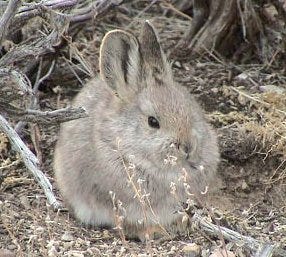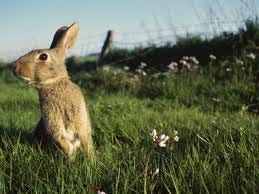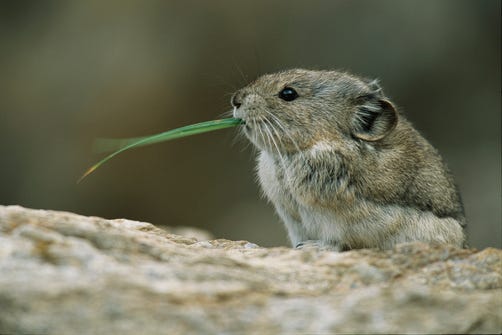By Jordan Schaul | National Geographic | March 24, 2013
Ten years ago this coming Easter, one of the world’s foremost experts on rabbits was asked to comment for National Geographic News on the conservation status of these small mammals and related taxa—species comprising the order Lagomorpha (i.e., rabbits, hares, and pika).
Back in 2003, Dr. Andrew Smith a biology professor and a Distinguished Sustainability Scientist at Arizona State University provided Nat Geo with a highlight summary of an IUCN conservation assessment for lagomorph species, including reports on populations of greatest concern to conservationists. In the summary, which was based on 2003 census data and earlier studies, the professor and then-chair of the IUCN specialist committee responsible for reviewing the status of rabbits and related species, emphasized that North America and Europe are home to at least two of the most highly imperiled lagomorph populations in the world.
Last week, Dr. Smith who continues to chair the IUCN Lagomorph Specialist Group, and I corresponded in regard to the current statuses of three rabbit species or populations previously reported on in 2003, and two new updates for other “species of concern” based on studies conducted during the past decade.
In the 2003 report summary, it was indicated that rabbits and other lagomorph species are important players in ecosystem health, citing for example their impact on predator-prey food chain dynamics. According to data collected for new studies referenced in the updated IUCN Red List Assessment, this claim continues to be supported, but new research also strongly suggests that at least one lagomorph species serves as an indicator species of contemporary climate change.
Here is a synopsis for you rabbit aficionados:
As mentioned above, North America and Europe are home to some fairly unique and stressed populations of rabbits. Spain’s European rabbits (Oryctolagus cuniculus) represent a population endemic to the region, like the rabbit, not to be confused with the European hare (Lepus europaeus), is also native to Portugal and Morocco. Unfortunately, like most rabbit species the prolific lagomorph has heavily populated many regions outside of Western Europe through introductions to a number of locations, including areas home to very fragile ecosystems, which are in some cases home to conservation-dependent flora and fauna. However, the rabbit population on the Iberian Peninsula is at a critically low number having succumbed to at least two infectious diseases—one being a lethal pox virus.
And you are likely unaware that Europe’s noisiest anuran—the natterjack toad—relies heavily on rabbit-grazed dunes to breed. Yes, the European rabbit, if not charismatic enough in its own right, is directly responsible for the survival of one of the world’s most charismatic amphibians. And I would be remiss not to mention that the European rabbit is also incredibly important to the survival of one of Earth’s rarest and highly charismatic carnivorans. Indeed, the rabbit is the staple food source of the world’s most endangered felid—the Iberian or Spanish lynx. This predator-prey dynamic is not unlike that of North America’s snowshoe hare and its predominant predator—the Canada lynx. Unfortunately, the aforementioned poxvirus—myxoma virus—had nearly wiped out the population of European rabbits on the Iberian Peninsula, rendering the Iberian lynx nearly extinct in the wild. Hence, this species of lagomorph is clearly a significant player in ecosystem health and remains critical to the survival of other faunal groups. The lesser-known impact on species diversity demonstrated by the rabbits’ influence on herpetofauna is just one other example of how rabbits contribute to the survival of other wildlife species (http://www.norfolkwildlifetrust.org.uk/Wildlife-in-Norfolk/Species/Amphibians-and-Reptiles/Natterjacktoad.aspx; http://www.herpconstrust.org.uk/dgssearch/search.php?q=natterjack&r=40).
I should note that the grazing behavior of rabbits has long proven to change floral diversity and perhaps it shouldn’t be too surprising that the diversity of some semi-fossorial and fossorial taxa such as some herpetofauna and more typically non-lagomorph small mammalians are impacted by the foraging activities of rabbits—activities that generally mitigate the detrimental effects of climate change. But more on climate change later.
The pygmy rabbit of North America’s Columbia River Basin is also in great jeopardy, representing another heavily stressed rabbit species. The species remains listed as endangered where it is found in Washington State and exists on the verge of extinction as it did a decade ago. To give you an idea of how rare the Columbia Basin pygmy rabbit is, census reports indicate that the population in Washington State occurs only in four counties. Fortunately, efforts to repopulate the region with the endangered lagomorph have met with some success thanks to organizations like the Oregon Zoo (http://www.oregonzoo.org/conserve/species-recovery-and-conservation/columbia-basin-pygmy-rabbits). This is also one of two American rabbit species known to dig their own burrow.
New information has been compiled and reviewed for two other North American species—the American Pika and the San Jose Brush Rabbit. Both received new Red List updates in response to recent reviews of the respective conservation statuses.
The extant population of nearly two million American pikas represents five subspecies. Although the population of pika is discontinuously distributed, the widely spread lagomorph is found throughout the mountainous regions of Western North America. Hence, it is no surprise that the American pika is listed as a species of Least Concern (IUCN Red list 2011), but the temperature-sensitive lagomorph does serve as an indicator species of climate change. As Dr. Smith said, “American pika are a harbinger of global climate change in populations at the extreme edge limits of their geographic range.”
Because of a Red List update published in 2008 for the Tehuantepec Jackrabbit, this species from Mexico deserves some attention. Also known as the Tropical Hare, this jackrabbit did not even make the list in our 2003 summary of lagomorph “species of concern”. However, with a great reduction in the quality of available habitat and the number of reproductively mature individuals in recent years, this species continues to be listed as endangered. In fact, less than 1000 individuals occur on only 520 square kilometers on the southern tip of mainland Mexico (IUCN Red List 2008). The historic range for this species along mainland Mexico’s Pacific Coast once encompassed 10 times what their current range is estimated to be, which suggests that the jackrabbit was not ever that widely distributed.
Outside of the US and Europe, rabbit populations continue to be compromised. The Karoo Desert of South Africa is home to a population of no more than 200 riverine or bushman rabbits. Besides having such a limited distribution, these bunnies are the least “prolific” of lagomorphs—producing only one offspring per litter.
Brazil and the Japanese Archipelago are home to two more species of rabbit populations, which are isolated and threatened to near extinction, as mentioned in the 2003 Assessment. In the meantime, the European rabbit, which was introduced to Australia, continues to create havoc on the island continent.
ABOUT NATIONAL GEOGRAPHIC SOCIETY
The National Geographic Society is a global nonprofit organization that uses the power of science, exploration, education and storytelling to illuminate and protect the wonder of our world. Since 1888, National Geographic has pushed the boundaries of exploration, investing in bold people and transformative ideas, providing more than 14,000 grants for work across all seven continents, reaching 3 million students each year through education offerings, and engaging audiences around the globe through signature experiences, stories and content. To learn more, visit www.nationalgeographic.org or follow us on Instagram, Twitter and Facebook.
MEET THE AUTHOR
Jordan Carlton SchaulWith training in wildlife ecology, conservation medicine, and comparative psychology, Dr. Schaul's contributions to Nat Geo Voices have covered a range of environmental and social topics. He draws particular attention to the plight of imperiled species highlighting issues at the juncture or nexus of sorta situ wildlife conservation and applied animal welfare. Sorta situ conservation practices are comprised of scientific management and stewardship of animal populations ex situ (in captivity / 'in human care') and in situ (free-ranging / 'in nature'). He also has a background in behavior management and training of companion animals and captive wildlife and conservation marketing and digital publicity. Jordan has shared interviews with colleagues and public figures, as well as editorial news content. In addition, he has posted narratives describing his own work, which include the following examples: • Restoration of wood bison to the Interior of Alaska (As Animal Curator at Alaska Wildlife Conservation Center and courtesy professor at the University of Alaska) • Rehabilitation of orphaned sloth bears exploited for tourists in South Asia (While executive consultant 'in-residence' at the Agra Bear Rescue Center managed by Wildlife SOS) • Censusing small wild cat (e.g. ocelot and margay) populations in the montane cloud forests of Costa Rica for popular publications with 'The Cat Whisperer' Mieshelle Nagelschneider • Evaluating the impact of ecotourism on marine mammal population stability and welfare off the coast of Mexico's Sea of Cortez (With Boston University's marine science program) Jordan was a director on boards of non-profit wildlife conservation organizations serving nations in Africa, North and South America and Southeast Asia. He is also a consultant to a human-wildlife conflict mitigation organization in the Pacific Northwest. Following animal curatorships in Alaska and California, he served as a charter board member of a zoo advocacy and outreach organization and later as its executive director. Jordan was a member of the Communication and Education Commission of the International Union for the Conservation of Nature (CEC-IUCN) and the Bear Specialist Group of the IUCN Species Survival Commission (BSG-SSC-IUCN). He has served on the advisory council of the National Wildlife Humane Society and in service to the Bear Taxon Advisory Group of the Association of Zoos and Aquariums (AZA Bear TAG). In addition, he was an ex officio member of the council of the International Association for Bear Research and Management.





